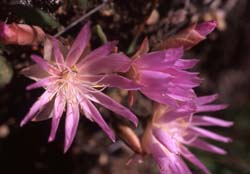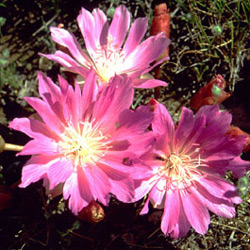State Flower Bitterroot
Updated: August 10, 2020

A decade before the Spanish American War colored Montana's seal, a more subdued movement began to add beauty and a mild fragrance to Montana's list of symbols.
Delegates to the 1889 Montana Women's Christian Temperance Union, meeting in Missoula, selected a "little blue flower that grows near the snow banks" as the WCTU's official state flower. Two years later, sentiment arose for change and the bitterroot received the WCTU's designation. A perennial, the bitterroot has an exquisite pink blossom which grows close to the ground and its delicate shadings offer the eye one of the loveliest of wildflowers.
The bitterroot (Lewisia rediviva) was a logical historical choice. In 1805, Meriwether Lewis and William Clark "discovered" the plant in the western Montana valley that now bears its name.

Montana's Indians used bitterroot as an important part of their diet. Tribes timed their spring migrations with the blooming of the bitterroot on the gravel river bars and hillsides. Dug, cleaned, and dried, the root provided a lightweight, nutritious supplement to a wild-game diet. At major trading centers like The Dalles, the root was an item of barter and exchange. A sackful commanded a substantial price such as a horse.
One ounce of dried root provided sufficient nourishment for a meal, but the plant was seldom eaten raw, for its bitter taste and resultant swelling caused great discomfort. More traditionally, Indian women boiled the root, then mixed it with meat or berries. Pulverized and seasoned with deer fat and moss, the cooked root could be molded into patties and carried on hunting expeditions or war parties.
With a strong Indian heritage and a name derived from the leader of the Lewis and Clark expedition, the bitterroot was most appropriate as a state symbol. In their contribution to the 1893 Columbia Exposition, Butte residents used the flower as the central figure on a large silver shield. That same year, in response to a national WCTU program, Mrs. Mary Long Alderson of Bozeman began efforts to secure legislative designation for the bitterroot as Montana's state flower.
Mary Alderson was the heart of the state flower movement in Montana. In January of 1894, she formed and headed Montana's Floral Emblem Association. County and community committees followed, as did floral meetings in most major cities and towns. The association set a state-wide referendum for fall. Interested men and women registered in their respective counties. Mrs. Alderson's committee then sent out a ballot to each registrant. Ballots had to be completed and returned by September 1, 1894.
Montana's press joined in the effort. Columns described the cause and the floral candidates. Editorials advocated this flower or that. When the polls closed, 5,857 ballots were in. More than 32 separate flowers received votes. The winner (with 3,621 votes) was the bitterroot, followed by the evening primrose (787 votes) and the wild rose (668). At Mrs. Alderson's urging, the 1895 Legislature responded to public preference and sanctioned the symbol.
Before long the delicate petals of the bitterroot graced stationery, posters, silverware, and even special sets of double damask Irish linen. The major credit for the addition of the bitterroot to Montana's list of official symbols belongs to Mary Long Alderson.
Visit montanakid.com's Plants and Animals section to learn more about Montana's flowering plants.
Special Acknowledgements to: Montana Historical Society, Rex C. Meyers and Norma B. Ashby
Updated: August 10, 2020

